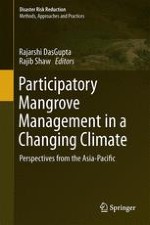2017 | OriginalPaper | Buchkapitel
9. Livelihood Strategies and Resource Dependency Nexus in the Sundarbans
verfasst von : Md. Nasif Ahsan, Karina Vink, Kuniyoshi Takeuchi
Erschienen in: Participatory Mangrove Management in a Changing Climate
Verlag: Springer Japan
Aktivieren Sie unsere intelligente Suche, um passende Fachinhalte oder Patente zu finden.
Wählen Sie Textabschnitte aus um mit Künstlicher Intelligenz passenden Patente zu finden. powered by
Markieren Sie Textabschnitte, um KI-gestützt weitere passende Inhalte zu finden. powered by
